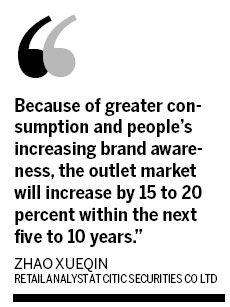Chinese finding more outlets for shopping habits
Updated: 2012-04-29 07:04
By Li Woke(China Daily)
|
|||||||
Ten years ago, the first outlet mall in China, Yansha Outlets, opened on the Third Ring Road in Beijing by the Yansha Youyi Shopping City.
That proved to be the first tumbling rock that started a landslide. The country, the third-largest market for luxury goods, is now home to hundreds of shops that can be grouped together under the category "outlet malls".
Lin Zhuoyan, chairman of Outlets (China) Ltd, said China has more than 200 such malls. Even so, fewer than 10 of them typically offer high-quality products at bargain-basement prices, a defining practice of outlets.
One of the most famous such stores in Shanghai, Bailian Outlets Plaza, which is supported by the swimwear and undergarment maker Shanghai Bailian Group Co Ltd, saw its net profits increase by 50 percent from 2006 to 2009. In the latter year, the mall had 39 million yuan ($6.19 million) in net profits, a 31.6 percent increase year-on-year, the financial services company CITIC Securities Co Ltd said.
"Because of greater consumption and people's increasing brand awareness, the outlet market will increase by 15 to 20 percent within the next five to 10 years," said Zhao Xueqin, a retail analyst at CITIC Securities.
The management consultancy McKinsey and Co expects the middle class in China to go from making up 29 percent of the 190 million urban households to 75 percent of the 372 million urban households by 2025.
As wealth becomes more prevalent, the Chinese are expected to spend more on luxuries.

According to Frost & Sullivan Inc, a US market consultancy, China spent 220 billion yuan on luxuries in 2010, a figure that had shown a compound annual growth rate of 26 percent since 2006. In 2015, that figure is expected to increase to 570 billion yuan.
To meet the country's increasing enthusiasm for luxury goods, some outlets in China are offering high-end products at discounted prices.
The Florentia Village, a luxury outlet that opened last year between Beijing and Tianjin, was built by the Italian luxury real estate developer and fashion retailer RDM Group in partnership with the US-based Waitex Group. It offers 200 famous luxury brands, including Prada, Salvatore Ferragamo, Fendi and Bulgari. It also discounts its prices by as much as 70 percent.
"In order to compete against other rivals in the market, we will provide customers with hundreds of brands carrying a 60 to 70 percent discount," Outlets (China) Ltd said.
"We'll also try to purchase products from the brands' parent companies abroad instead of their sales agencies in China."
"Our goal is to set up a new town led by outlets," Lin said.
"Outlets stores are the engine of the business model," said Liu Xiaoguang, a director at Outlets (China) Ltd and chairman of the board of directors at Beijing Capital Land Ltd.
"Many modern commercial service clusters will be introduced as well, such as entertainment squares, convention centers, cinemas, supermarkets and hotels."
Wan Wenying, vice-president of China General Chamber of Commerce, said the malls should vary in accordance with where they are built.
"Each city has different consumer groups, different spending habits and different degrees of brand awareness," Wan said. "So outlets must find the most suitable operating method based on the actual local situations."
liwoke@chinadaily.com.cn
(China Daily 04/29/2012 page9)